ARM Cortex A12: Between Cortex A9 and A15 in Power & Perf, Sampling in Late 2014
by Anand Lal Shimpi on June 2, 2013 11:31 PM EST- Posted in
- Smartphones
- CPUs
- Arm
- Mobile
- Tablets
- Trade Shows
- SoCs
- Cortex A12
- Computex 2013
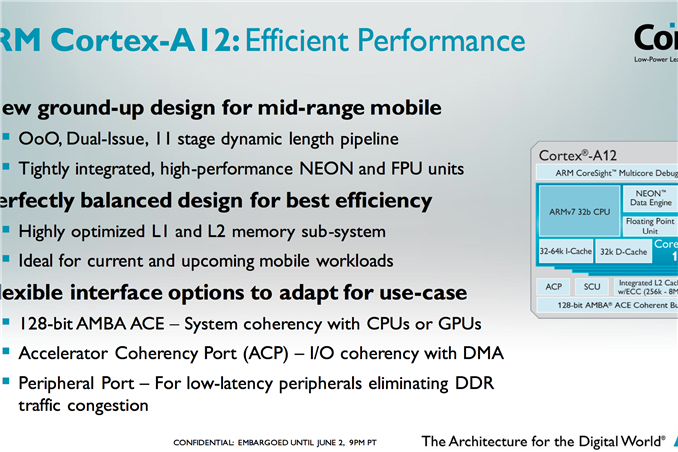
We’ve talked about the hole in ARM’s product lineup for quite a while now. The Cortex A9 is too slow to compete with the likes of Intel’s Atom and Qualcomm’s Krait 200/300 based SoCs. The Cortex A15 on the other hand outperforms both of those solutions, but at considerably higher power and die area requirements. The slide below from Samsung illustrates my point clearly:
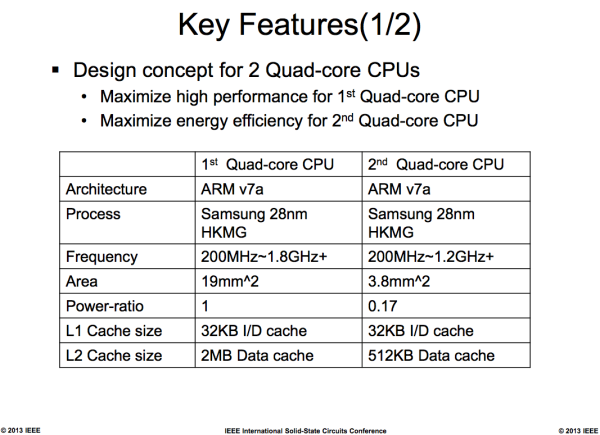
The comparison point here is the Cortex A15 and Cortex A7, but the latter should be quite performance competitive with a Cortex A9 so the comparison is still relevant. The Cortex A15 island in Samsung’s Exynos 5 Octa occupies 5x the die area as the A7 island, and consumes nearly 6x the power. In exchange for 5x the area and 6x the performance, the Cortex A15 offers under 4x the performance. It’s not exactly an area or power efficient solution, but a great option for anyone looking to push the performance envelope.
Today, ARM is addressing that hole with the Cortex A12.
This announcement isn’t a deep architectural disclosure, but we do have some high level details to share. Like AMD’s Jaguar, Intel’s Silvermont and even ARM’s A9, the Cortex A12 is a dual-issue out-of-order architecture. Unlike the Cortex A9, the Cortex A12 is fully out-of-order including the NEON/FP units (NEON/FP was in-order on Cortex A9).
Pipeline length increased a bit compared to Cortex A9 (11 stages), however ARM told me to expect similar frequencies to what we have with the Cortex A9.
The execution back end has also been improved, although I don’t have many details as to how. My guess is we should expect something a bit wider than Cortex A9 but not nearly as wide as Cortex A15.
Memory performance is much improved compared to Cortex A9 as well, which we’ve already demonstrated as a significant weak point in the A9 architecture.
All of the architectural enhancements are supposed to provide up to a 40% increase in performance (IPC) over Cortex A9 at the same frequency and process node. ARM isn’t talking power, other than to say that it can do the same workload at the same power as a Cortex A9. In order words, Cortex A12 should have higher power than Cortex A9 but faster execution reduces total energy consumed. With a higher max power we’ll see more dynamic range in power consumption, but just not nearly as much as with the Cortex A15.
Cortex A12 also adds support for 40-bit memory addressability, an intermediate solution before we get to 64-bit ARMv8 based architectures. Finally, Cortex A12 features the same ACE bus interface as Cortex A7/A15 and can thus be used in big.LITTLE configurations with either core (but likely exclusively with the A7s). Given the lower power profile of Cortex A12, I'm not sure the complexity of doing a big.LITTLE implementation will be worth it though.
ARM expects the Cortex A12 to be used in mainstream smartphones and tablets where cost and power consumption are a bit more important. The design makes a lot of sense, the only downside is its launch timeframe. ARM expects to be sampling Cortex A12 in late 2014 with the first devices showing up in 2015. Update: ARM clarified that SoCs based on Cortex A12 would be shipping to device vendors in mid-2014, with devices shipping to consumers by late 2014 to early 2015. ARM has optimized Cortex A12 processor packs at both Global Foundries (28nm SLP) and TSMC (28nm HPM).


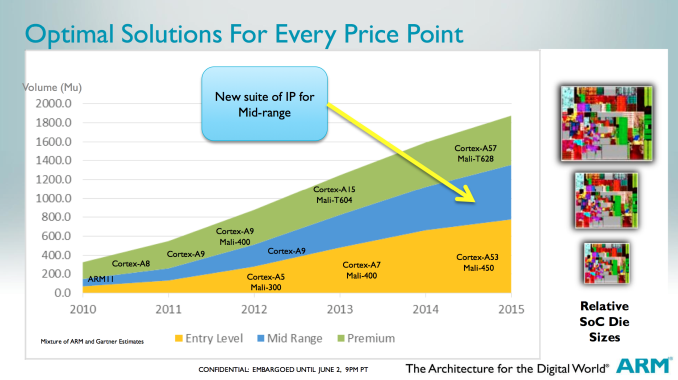
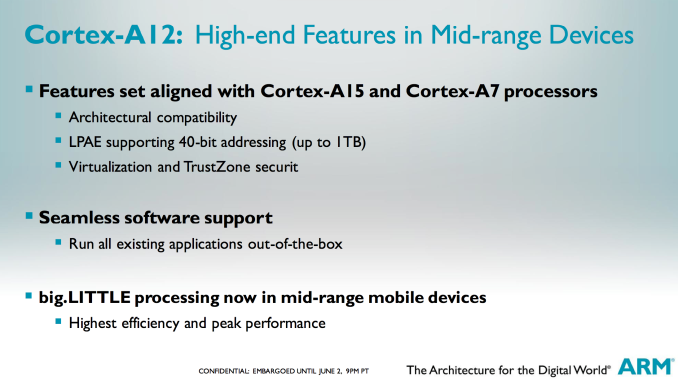
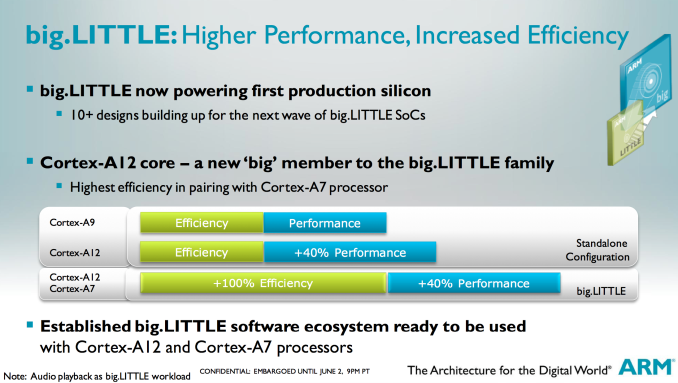








78 Comments
View All Comments
Wilco1 - Tuesday, June 4, 2013 - link
Yes like many on here you seem confused. This is not a high-end chip, it's simply a faster and more efficient replacement of Cortex-A9. You know, not everybody in the world can afford an S4 or iPhone. Check out the cheap devices based on Allwinner, MediaTek and Qualcomm SoCs which are selling well in Asian markets. They use 65nm and 40nm processes, and some still use Cortex-A8! Why? Because it's far cheaper to use old processes and old cores.Currently the quad Cortex-A7 at 1.2GHz is replacing the old Cortex-A9 as the low-cost top-end at 40nm (as Cortex-A7 is far more efficient and cheaper). Cortex-A12 on 28nm in early 2015 fits perfectly in this large market of cheap devices made on old processes. The A15 won't be used in this market until it is obsolete and cheap.
Note Cortex-A12 is faster than A9R4 as used in Tegra 4i (A9R4 is ~15% faster, A12 is 40% faster than A9).
TheJian - Wednesday, June 5, 2013 - link
Umm, you must have missed the fact that T4i is aimed at $200 phones in...wait for it...ASIA, thus something coming a bit faster FAR later is pointless. It will be facing a T5i which I'm sure will make up the difference in anything A12 adds right? I missed nothing, neither did anyone else. T3 as sold to Google & MS was only $23 roughly. How much cheaper do you think a chip needs to be? At these prices (and T4i is smaller as T4 full is only 81mm which is the same as T3's 80mm), you can't get much cheaper and T4i should easily be able to sell for the same and we're not talking the savings of 20nm this A12 will be facing next year by everyone not just NV.Are you trying to tell me the difference between a $600 phone and $200 phone can be made up by making a $23 soc cheaper on old process tech? ROFL. OK man. Whatever. Even if NV gave the soc away free, the difference is $23 bucks. Do you think they hand you $100 AND give you the A12 free for using it? You are not going to magically enter untapped markets etc over $23. You are making a ridiculous argument I'm afraid. It would perhaps be a good one if you could show me the price of an A12 is less than $23 (first) and NV was charging $200 for a soc (2nd). Then I would get your point. But at $23 for T3, I'm guessing the BEST A12 can do on a LARGER process node than T5i etc, is a few bucks tops. Even if I am TOTALLY generous here and give you a $10 advantage (this assume they can make it for $13 and have a 40-50% margin AT that price...LOL) you are not magically getting into cheaper markets...We are talking $10 and there is no way I believe it will be FAR cheaper to produce an A12 at 28nm than whatever cheapo units everyone makes at 20nm. If the max cost is around $23 now, it's miniscule differences we're talking here, not hundreds of dollars. T4i is NOT a high end chip...T4 is.
http://gigaom.com/2013/02/19/nvidia-launches-its-q...
"The Tegra 4i is part of what will now be a family of Tegra 4 smartphone chips, with the 4 aimed at high-end phones and tablets and the 4i aimed at phones in the $100 to $200 range."
I'm actually giving you a great benefit saying it's aimed at $200 phones. Clearly I can find sites saying $100-200. How cheap do you think A12 is aimed at? Again, I missed NOTHING.
http://www.pcmag.com/article2/0,2817,2415515,00.as...
PC magazine says UNDER $200 for T4i. Are we done here? All clear?
"Tegra 4i has that nailed down. It's half the size of competing chipsets like the Tegra 4 and Qualcomm's Snapdragon 800, and according to Nvidia it's up to 2.5 times as efficient per square millimeter, which means it's able to deliver the performance we think of from top-end phones in devices that will cost $100-200 without any subsidy."
So even PC mag says $100-200. I'm not sure where they get that T4i is 1/2 size of T4, but I know it is vs. S800. I guess we'll have to wait to see if T4=S800 (I thought S800 was a good bit bigger than T4 full). Either way, the point is YOU are the one who seems confused. Unless S4 and iPhone are suddenly selling for $100-200 without contract subsidy? I must have missed that. I'm running off to by a $200 S4 now... /sarcasm. We'll see how big A12 is in the end, but you are not going to knock much off of $23 already. I guess you're just having trouble with simple math and economics :) T4i will do just as well in those $100-200 markets (unlike T3) because it now has a MODEM. This is the only thing that kept it from competing before in phones. Well, it didn't perform like a T4i either...LOL. But you get the point. It was modem-less which causes most to look at Qcom instead. That will be different this time.
"R4 has 15-30 percent higher performance per clock cycle than the A9s used in chips like the Nvidia Tegra 3, and can be cranked up to even higher clock speeds;"
You need to read more...PCmag article said that too. So 15-30% and that's BEFORE upclocking it. A 2.3ghz T3 would be impressive vs even a T3 1.4ghz from last year (or even T3+1.7ghz). But add in the 15-30% and 5x the gpu's. I don't see the point in A12 as many others don't here. To get into $100-200 phones you aren't selling the T4i at more than $25 right?
This is straight from NV's Matt Wuebbling (he's the guy I'm quoting from PCmag article), the director of Nvidia's mobile business. He should know where they are aiming their T4i right?
Whatever...
Wilco1 - Wednesday, June 5, 2013 - link
I totally don't get your huge rant about Tegra 4i. We are talking about A12 and what markets it will be used in, which has nothing to do with Tegra 4i. The 4i is an interesting chip and I hope it will be successful, but A12 will clearly surpass the A9R4 in every aspect it when it comes out. If there will be a Tegra 5i, then I bet it will be based on A12.Tegra 4i may well go after the Asian markets, but at ~$23 Tegra 3 is way too expensive for the $50-$100 devices that Allwinner, Mediatek etc are selling. Yes, the SoCs in those are in the $5-$10 range. I don't believe the 4i can go that low.
speculatrix - Wednesday, June 26, 2013 - link
@Wilco1 thanks for that. Is there a simple chart showing the various Arm-derivative processor architectures with their performance and performance/watt in a table normalised to a "standard" process/geometry, along with the best performance that each variants can managed on the best fab's process?michael2k - Sunday, June 2, 2013 - link
What's the fundamental difference between an A12 and Apple's Swift architecture?http://www.anandtech.com/show/6330/the-iphone-5-re...
There's a similar 40% perf improvement in some cases and there are also memory improvements.
cmikeh2 - Monday, June 3, 2013 - link
Swift is a 3 wide out of order front end whereas the A12 is dual issue.tuxRoller - Monday, June 3, 2013 - link
Possibly the fully OoO pipeline in A12 to make up for the frontend.fteoath64 - Monday, June 3, 2013 - link
Good question!. It goes for the Tegra 4i as well which optimizes with dual channel memory and enhancements to the tune of 30% over A9. The issue here is the reference A9 has been improved by the likes of Apple, Nvidia maybe others so the gap between A9 to A15 needs to be plugged as A15 shift has slowed for power reasons. A12 is a great fit and there is market demand due to "good enough" graphics on tablets/phone today.WaltFrench - Monday, June 3, 2013 - link
This sounds like, “the A12 presents similar types of enhancements to what Apple & nVidia have been implementing, just a couple of years later.” Or am I missing something?lmcd - Tuesday, June 4, 2013 - link
Nope. There's probably more work done, though, since it sounded like there are more base improvements. And Nvidia never made that performance claim IIRC, which makes sense as the A9 upgrades (note: which were done by ARM, not Nvidia) were incremental enough that ARM didn't designate a new processor name, like they did here.A12 will beat A9r4 or w/e, but not Swift (most likely).
The other main point is it's big.LITTLE compatible with A7 and A15. So it must be fundamentally different than the A9 and add a few things to maintain that compatibility.